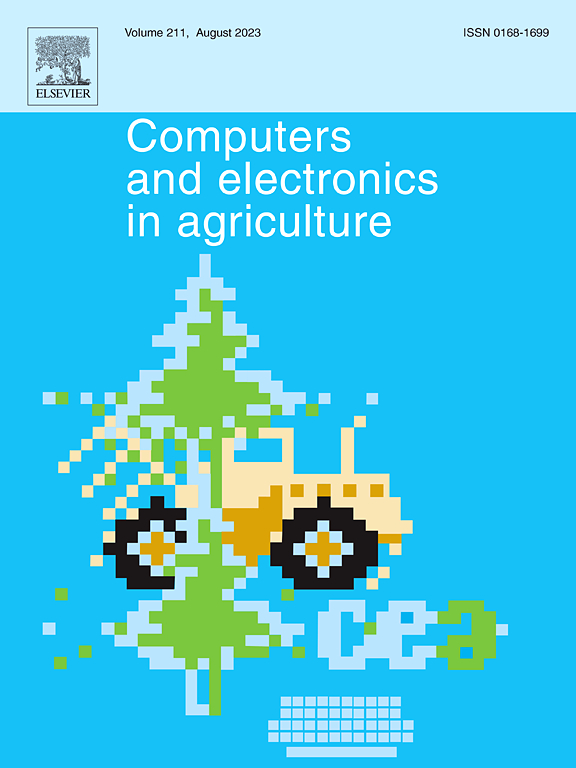基于纳米纤维毡的连续土壤硝酸盐传感土壤吸水技术
IF 8.9
1区 农林科学
Q1 AGRICULTURE, MULTIDISCIPLINARY
引用次数: 0
摘要
持续监测土壤硝酸盐水平对有效的土壤养分管理至关重要。然而,在低土壤含水量水平下,有限的土壤孔隙水阻碍了微型土壤传感器表面与营养离子的有效相互作用。为了解决这个问题,我们引入了一种纳米纤维垫,旨在通过增加微型传感器和土壤溶液之间的连接来增强硝酸盐检测。这种垫子由聚砜、聚甲基丙烯酸甲酯和聚乙烯醇组成,采用静电纺丝和电喷雾方法制造,以平衡吸水性、机械耐久性和易于制造。当包裹在一个离子选择性电极硝酸盐传感器上时,垫改善了土壤孔隙水的进入,起到过滤器的作用,防止传感器与土壤颗粒直接接触,并减少土壤颗粒表面电荷对传感器测量的影响。在控制环境和野外环境下,采用毡包式和裸传感器进行了硝酸盐的连续监测。线性回归分析表明,垫包传感器与传统的盐提取法测量土壤硝酸盐水平具有较强的相关性。t检验证实了传感器测量和盐提取方法之间的统计显著差异。此外,Bland-Altman分析表明,垫包减少了平均偏差,缩小了一致性的限制,表明与传统方法相比,一致性得到了改善。值得注意的是,垫子包裹的传感器在不同的土壤湿度条件下表现一致。这些发现表明,吸水垫通过适应随时间变化的土壤湿度水平,提高了传感器连续监测硝酸盐的能力,使毡包土壤硝酸盐传感器成为土壤溶液化学现场测量的可行改进。本文章由计算机程序翻译,如有差异,请以英文原文为准。
Nanofibrous mat-enabled soil water absorption for continuous soil nitrate sensing
Continuous monitoring of soil nitrate levels is essential for effective soil nutrient management. However, limited soil pore water at low soil water content levels hinders miniaturized soil sensor surfaces from efficiently interacting with nutrient ions. To address this, we introduce a nanofibrous mat designed to enhance nitrate detection by increasing connectivity between miniature sensors and the soil solution. Composed of polysulfone, polymethylmethacrylate, and polyvinyl alcohol, this mat is fabricated using electrospinning and electrospray methods to balance water absorbency, mechanical durability, and ease of manufacturing. When wrapped around an ion-selective electrode-based nitrate sensor, the mat improves access to soil pore water, acts as a filter, prevents direct sensor-soil particle contact, and reduces the impact of soil particle surface charges on sensor measurements. Continuous nitrate monitoring with both mat-wrapped and bare sensors was conducted in controlled and field environments. Linear regression analysis indicates that the mat-wrapped sensor has a stronger correlation with conventional salt extract methods for measuring soil nitrate levels. T-tests confirm statistically significant differences between sensor measurements and the salt extraction method. Additionally, Bland-Altman analysis reveals that mat-wrapping reduces mean bias and narrows the limits of agreement, demonstrating improved agreement with the conventional method. Notably, the mat-wrapped sensor performs consistently across varying soil moisture conditions. These findings suggest that the water-absorbing mat improves the ability of the sensor to monitor nitrate continuously by accommodating varying soil moisture levels over time, making the mat-wrapped soil nitrate sensor a viable improvement for in-field measurements of soil solution chemistry.
求助全文
通过发布文献求助,成功后即可免费获取论文全文。
去求助
来源期刊

Computers and Electronics in Agriculture
工程技术-计算机:跨学科应用
CiteScore
15.30
自引率
14.50%
发文量
800
审稿时长
62 days
期刊介绍:
Computers and Electronics in Agriculture provides international coverage of advancements in computer hardware, software, electronic instrumentation, and control systems applied to agricultural challenges. Encompassing agronomy, horticulture, forestry, aquaculture, and animal farming, the journal publishes original papers, reviews, and applications notes. It explores the use of computers and electronics in plant or animal agricultural production, covering topics like agricultural soils, water, pests, controlled environments, and waste. The scope extends to on-farm post-harvest operations and relevant technologies, including artificial intelligence, sensors, machine vision, robotics, networking, and simulation modeling. Its companion journal, Smart Agricultural Technology, continues the focus on smart applications in production agriculture.
 求助内容:
求助内容: 应助结果提醒方式:
应助结果提醒方式:


